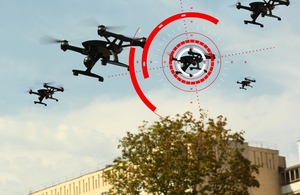The UK Home Office and Department for Transport (DFT) is adding an additional GBP1.5 million funding to the Defence and Security Accelerator’s (DASA) Countering Drones competition. Putting in this additional funding brings the new total to at least GPB3 million and should more than double the number of proposals that the government will be able to award for the competition according to the Home Office.
DASA is looking for solutions aimed at addressing the threat of unmanned air systems. It seeks proposals that can develop the technology needed to counter Unmanned Air Systems (C-UAS) and demonstrate how these can be integrated together to form a capable system. This is the second phase in a multi-phase competition. Proposals need to meet one or more of the following criteria: Provide fixed site protection; mobile protection; and/or maritime protection.
In light of this additional funding, the deadline for the competition has been extended by 10 days. Proposals for funding to meet these challenges must be submitted by Friday 31st July 2020.
The Home Office Counter-Drones Unit owns domestic counter-drones policy for the government, working closely across the government and operational partners to understand risk and operational requirements. The government priority is to help industry and academia to deliver world-leading counter-drone solutions to support the safe and responsible use of drones in the UK. This DASA competition provides an immediate opportunity to help us further develop the critical counter-drone technical capabilities we need at pace, and to support counter-drone exploitation routes in the future.
the Home Office and the DfT are working closely with the Defence Science and Technology Laboratory (Dstl) in support of Phase 2 of this DASA competition.
For this new funding, the UK government is particularly keen to hear from industry and academia who have innovative solutions to respond to domestic security needs. A scenario could include numerous drones being used at an important installation, major event or demonstration over a wide, complex geographic area, and over a prolonged period of time. The small UAVs (sUAVs) could be a mix of commercially available, high performance multirotor types, being operated directly in a planned and sophisticated manner. They could also include legitimate drones. The intent of the sUAVs could range from surveillance to malicious disruption or attack. There may be electronically sensitive infrastructure in the area.
The Home Office is interested in C-sUAS solutions that can be static, mobile, portable or temporarily deployable on vehicle(s), to:
- Detect presence of sUAVs
- Determine location, intent and assess the risk posed
- Locate operator
- Enforce a ‘no-drone’ zone
Despite the challenge of COVID-19 the Government is dedicated to continuing to collaborate closely with the drone and counter-drone industries. This work will therefore be in lieu of a separate Home Office Counter-Drone Unit Grand Challenge this financial year, to reduce the burden on industry that different competitions bring. The outputs from this enhanced DASA competition will still allow the Home Office and DfT to scope the focus for any potential future investment in developing counter-drone technologies.
For more information visit:
https://www.gov.uk/government/news/countering-drones-phase-2-competition-gains-extra-funding




